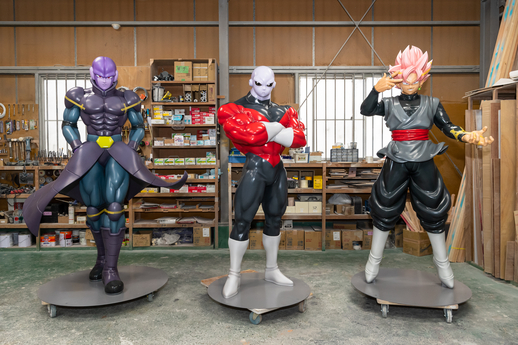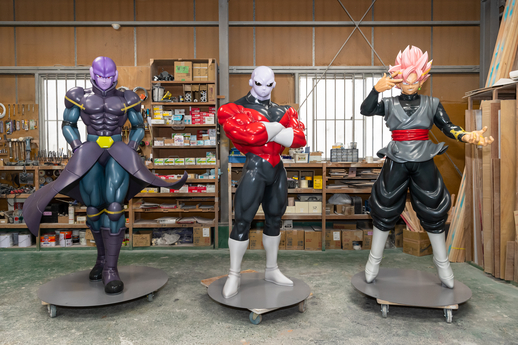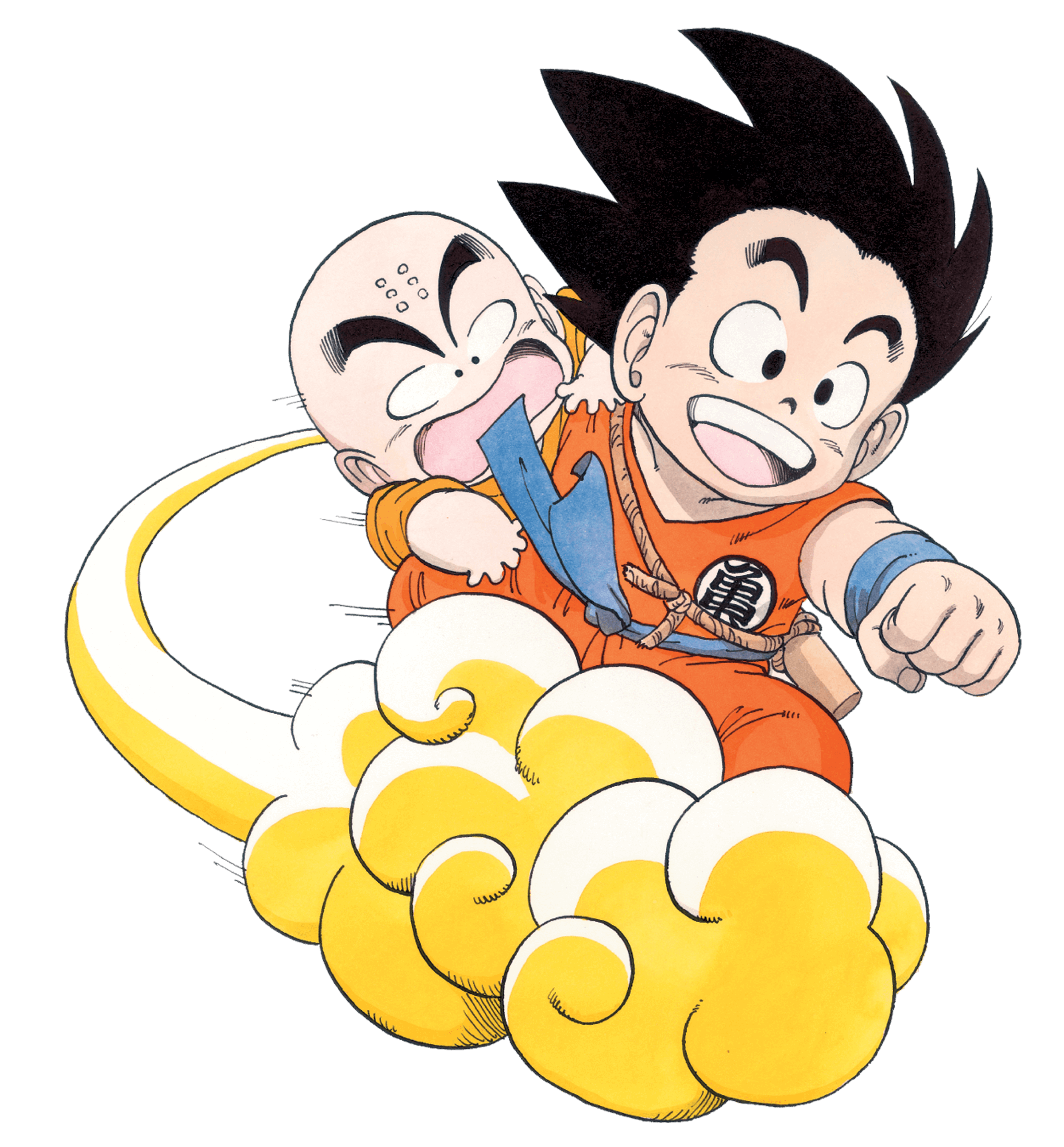NEWS
24.03.2023
Dragon Ball Super Statue Production Ground Floor Report Part 2: The Creation of Goku Black, Jiren, and Hit!

The new statues of Goku Black, Hit, and Jiren shown above were exhibited at DRAGON BALL Games Battle Hour 2023!
Here in Part 2 of our report from the statue creation ground floor, we'll go over just how these fantastic statues were brought to life.
Part 1 of our report covered statue production company Jincraft Inc.'s philosophy on recreating characters as statues as well as the basics of their craft.
Check it out below if you haven't already!
Dragon Ball Super Statue Production Ground Floor Report Part 1: What Makes These New Statues Great!
Like we mentioned in Part 1, statues are created through the combined efforts of three teams: the 3D data modeling and prototyping team, the mold-making and FRP casting team, and the painting team.
Here, we'll be zooming in on the production process to show you just how these statues are made from start to finish!
3D Data Modeling
This is the first step of the production process. Once the characters and their poses have been decided upon, they are created digitally as 3D data on a computer. Special consideration also needs to be taken during this step in regard to the way individual parts of the statues need to be divided up so as to not obstruct the mold-making, finishing, and coloring work that comes later.
Prototype Production
Next, a special machine uses the 3D data created earlier to carve out the prototypes! The process is automatic once it starts, but the key to getting good prototypes from the data lies with the experience, expertise, and creativity of the staff who program it!

The prototypes are mostly made of Styrofoam, but sometimes the finer parts need to be made using a 3D printer, like Goku Black's Ring of Time and Potara Earring.
Once the automatic carving is finished, the prototypes undergo some manual finishing by the staff. They use a wide range of tools and implements, ranging from plain old sandpaper to specialized tools they actually created by themselves back when prototyping all had to be done by hand!
How cool is that?!
Mold-Making
Just like when making plaster figures, the prototypes are then used as bases to create molds for production. Before the molds are taken, they have to put strips around the prototypes so that the two halves of the molds can be separated cleanly afterward.
A special kind of clay also needs to be applied to the prototypes before the molds are created so that they can actually take them off later.
You might think that the mold above looks finished already, but there's still a long way to go!
After prepping the prototypes for mold-making, it's time to make the plaster molds!
A layer of plaster mixed with flax fibers is painted over the prototypes in a layer around 8 mm in thickness, and at the same time wooden frames are built around them to stop the plaster or prototypes from breaking.
Little by little, thin and light yet strong molds are built up around the prototypes!
Once the plaster has set, the prototypes are removed from the molds.
Since the prototypes are made of soft Styrofoam, there's no risk of them scraping the inside of the molds on their way out either!
There you have it! A perfect mold of Jiren's face!
Now that the prototypes have been removed, the molds can be finished and dried.
Take a look at Jiren's stunning back muscles in that mold!
FRP Casting
Once the molds are done, they can be lined with FRP (fiberglass-reinforced plastic), the material for making the statue. But before that, preparation!
First, any parts of the plaster molds that chipped or cracked during the mold-making process need to be repaired.
With preparation complete, the FRP casting process begins by coating the insides of the molds with plastic resin and glass fibers. This means that the resulting statues are actually hollow like a crab leg after you've finished eating the meat inside, but that's not a problem thanks to the strength of FRP!
However, thin parts like Hit's coat can be a lot of work because they need to be coated with a thicker layer of FRP in order to attain the necessary level of toughness.
Once the FRP inside has set, the plaster molds can be broken away to take out the statues!
We're getting pretty close to the finished product now, but first the parts are taken away to be finished and detailed.
The head part whose mold we saw being created back in the mold-making stage turned out great in 3D!
This stage in the creation process is when fine parts of the statues can get damaged, so a lot of care was taken in the fine-tuning of Jiren's distinctive nose.
Any segments that got chipped or cracked get repaired with putty while the parts are finished and detailed.
Next, the separately cast parts are all fitted together! It looks just like Jiren!
Painting
Parts are fitted together for finishing and detailing, but after that they need to be separated again to be colored. One separated, the parts all get a fresh white undercoat to prevent any unevenness in the final paint job.
Paint is applied to the parts using tools like cup guns or airbrushes, where the amount of paint vs air being sprayed out needs to be carefully controlled.
Goku Black is transformed into Super Saiyan Rosé with a coat of sublime pink paint!
After the colors are all applied, the statues get a final layer of clear coating to finish up.
Base-Setting

Finally, the painted statues are fitted onto metal plates that serve as their bases. The Goku Black statue's feet are supported from the base with metal framing, so when you look at it from the front, it looks like he's levitating!
Those frames you can see actually extend all the way up to his thighs on the inside to prevent him from toppling over.

The base weighs around 35 kg, which is roughly equal to the statue itself, making the whole thing a total of approximately 70 kg. The reason that the statue part is able to remain so light despite its size is that it's hollow inside, as mentioned above.
All Finished!


With all the production steps completed, we finally have our finished statues!
In total, it took around 1,120 hours of work to get from zero to the completed statues we introduced in Part 1 of this report!
It somehow makes them look even better when you know how much effort went into making them, right?!
Before wrapping up the report, we also asked the experts at Jincraft Inc. what the hardest part of their job is!
Here's what they had to say:
"The hardest part would have to be giving the models the same impression as the characters themselves. Thanks to the experience we've gained over the years, there isn't much that gives us trouble from a technical standpoint, but since there are so many different people and stages that the models move between during production, it can be a challenge to maintain the same impression from start to finish."
It certainly sounds difficult, but you can really tell just how much care the people at Jincraft put into staying faithful to the characters from the modeling stage, to prototyping and adjusting, all the way to delivering the final touches.
Thank you very much to everyone at Jincraft Inc!
The Goku Black, Jiren, and Hit statues introduced in this article will be on display at the Toei Animation Booth at AnimeJapan 2023 on March 25-26 at Tokyo Big Sight.
Be sure to go and meet them in person if you're planning to attend!
©BIRD STUDIO/SHUEISHA
©BIRD STUDIO/SHUEISHA, TOEI ANIMATION
This site includes machine-translated texts. Please be aware that you might find some unusual expressions that are difficult to understand.
Post
Confirm Post
Post the above comment?
Reply
Confirm Reply
Post the above comment?
Are you sure you want to delete this comment?
Report successful
Post Unsuccessful
This user will be muted.
You will be unable to see comments from muted users in the comments area.
*To unmute users, navigate to the "Comments" area on MY PAGE.
Reply
Confirm Reply
Post the above comment?
Edit
Post


Post
Confirm Post
Post the above comment?
Edit
Post